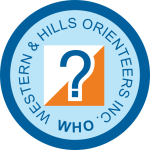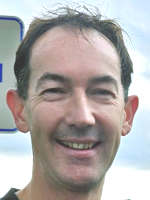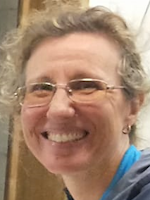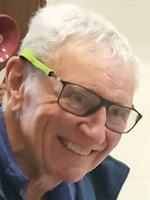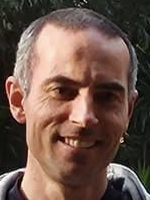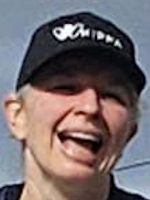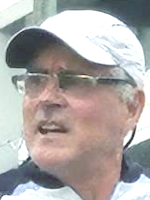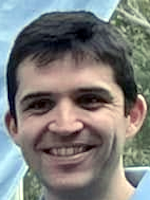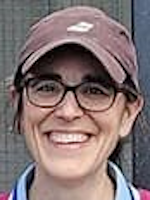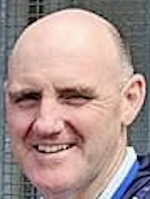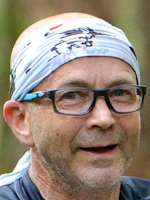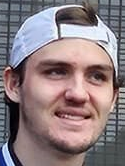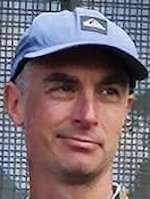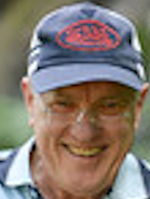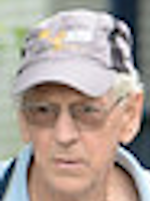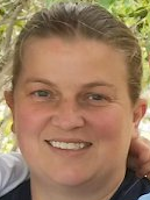ORIENTEERING
ITS BACKGROUND AND ORIGIN
BERTIL NORDENFELT
Stockholm, Sweden
1979
This is a digitised version of a pamphlet on the origins of Orienteering by Bertil Nordenfelt.
It was prepared for presentation to the VIII International Congress for the History of Sports and Physical Education,
in Uppsala, June 4-9, 1979.
The original pamphlet was published with the support of SVENSKA ORIENTEERINGSFÖRBUNDET
and STIFTELSEN SKOGSSPORTENS GYNNARE
The publishing house was Sturetryckeriet AB in Stockholm, Sweden.
(The publisher no longer exists).
This digital version is published with emendations March 2024.
CONTENTS
Summary
1. Introduction
2, Concrete conditions
3. Psychological conditions
4. Early origin
5. The first steps
6. The first non-military O
7. The time of lull
8. Regeneration
9. The avalanche was on its way
10. Ski-orienteering
11. International organisation
12. The future
Thanks!
About the Author
Bertil Nordenfelt celebrated great success as an orienteer well into his old age. He competed for a long time in the H68 class (men 68 years or older), but he thought it was a bit unfair that he was allowed to compete against juniors. Therefore, new classes were always established as the years passed. It became H80, H85 and H90. At the age of 90, he became a veteran world champion. Bertil passed away at the age of 94 and never got the chance to compete in H95.
Bertil founded the Swedish Orienteering Federation in 1936, together with the sports journalist and sports leader Torsten Tegnér. From the same year he was chairman of the association's executive committee and editor of its yearbook Skärmen. He was also the base of the Swedish Budo Federation for ten years, between 1971 and 1981, and chairman of the Stockholm Sports Federation for 30 years from 1935. For thirteen years he was a member of the board of the Swedish Sports Confederation. Nordenfelt was also active as a youth leader in the Scout movement.
Bertil Nordenfelt was the son of Hugo Nordenfelt. Nordenfelt matriculated in Östersund in 1921 and received his Bachelor's degree from Uppsala University in 1926. From 1927 to 1929 he was a teacher at Sunnerdahl's home schools in Säbyholm and was secretary of the collection Nordisk kultur and employed at the Nordic Museum from 1929 to 1931. From 1930 he was a contributor to Stockholms Dagblad and from 1931 to 1933 to Stockholms-Tidningen. In 1933 he joined Åhlén & Åkerlund's publishing house, and from 1942 he was sales controller for the Swedish Brewers' Association and from 1943 editor of Svensk bryggeritidskrift. Nordenfelt attended the gymnastics instructor course at Gymnastiska centralinstitutet from 1928 to 1929 and then became one of Stockholm's foremost sports leaders. He is buried in the memorial garden at Galärvarvskyrkogården in Stockholm.
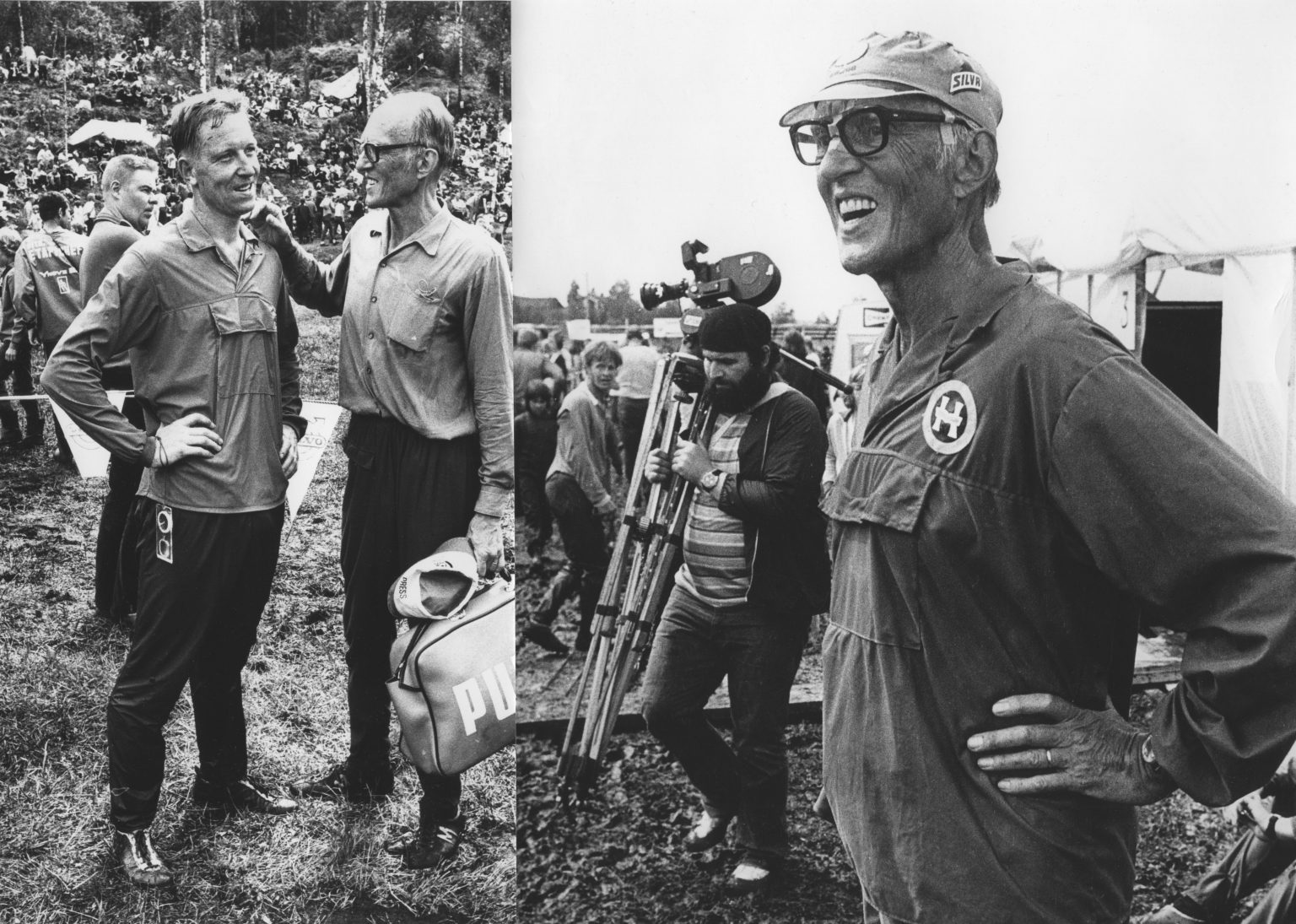
Bertil at O-ringen five-days in Småland 1974
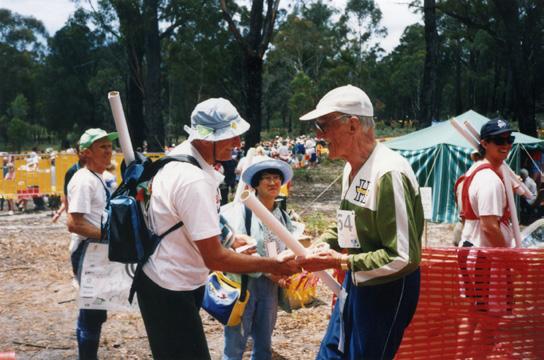
Bertil at the Orienteering World Masters Championships, Tasmania 1992.
Sources:
Nordenfelt, 8. Bertil in Svenska män och kvinnor (1949)
https://nordenfelt.info/kanda-nordenfeltar/bertil-nordenfelt-redaktor-och-orienterare-1903-1998/
Wiliwand
SUMMARY
Orienteering is a young sport but one that has become popular the world over. It is the art of finding one's way in an unknown area. The goal of this paper is to analyse the background of this sport and document its origin and earliest development.
Three concrete conditions are essential for orienteering: available territory, good map and a reliable compass. Three psychological factors have prompted the origin and furthered the fast spreading of the sport instinct to discover, longing for adventure and the "back to nature" movement, all prevalent in Scandinavia.
Topographical maps were originally made for military use. The first indications of orienteering as a competitive sport have been found in the Swedish Army (1888) and the Norwegian Army (1895). The first civilian competition seems to have been organised on 31 October 1897 (with 8 participants) by the sport club Tjalve outside Oslo, Norway. In spite of a number of other small events up to 1910, the sport died out in Norway but in Sweden it survived World War I.
On 25 March 1919, the first large competition - with over 200 participants - was organised in the forest of Nacka, outside Stockholm. From there the interest spread like wildfire throughout Sweden and later (about 1925) to Finland, Norway and (especially after World War II) to other countries in Europe and elsewhere. The initiator, Major Ernst Killander, is called "The Father of Orienteering".
In 1961, the International Orienteering Federation was founded in Copenhagen. Today it has 23 national member associations and 300 000 competitors in 4 000 clubs, with its own world championships and (since 1977) Olympic status. Orienteering is quickly developing into a fascinating sport for all and a salubrious leisure-time activity all over the world.
l. Introduction
Orienteering as a competitive sport1 is today (1979) practised by over 300 000 men and women between the ages of 7-70 years. There are about 4 000 clubs on all the five continents. Since 1961, orienteering has its own international federation (IOF), with 23 national member associations and its own world championships. Since 1977, it has Olympic status and has grown rapidly into a fascinating mass sport and a popular way to relax and improve one's health.
However, very few know what orienteering is and most people have never even heard the word orienteering.2 This fact is due to the comparatively recent breakthrough of this Nordic sport, which occurred during the mid-1950's. Orienteering as a modern competitive sport is not older than 60 years (1919).3
Few sports can date back their origin to a certain specific time, place or person. This is the case, however, with basketball (December 1891, Springfield College, Mass., USA, Mr. James Naismith).4 Sport as a physical activity generally has its origin in .the necessity of mankind to be stronger, quicker and more skilled in defence or attack, in struggling for the preservation of life. Another reason for sport is the inherent need of man for self-assertion, adventure, games and relaxation
This is also true with regard to orienteering. Even though the birth of modern orienteering, as stated below,3 can be dated back to the race on 25 March 1919 outside Stockholm, Sweden, there was a long period of unfulfilled need, ‘with many groping efforts. made in various countries - following the Swedish initiative.
The object of this paper is to analyse the background of the modern sport of orienteering and to document its origin and earliest development.
2. Concrete conditions
There are three essential concrete conditions for orienteering - available outdoor areas, large-scale maps and an instrument indicating direction.
2.1 Territory
Although the ground surface varies greatly in different parts of the world, there are wooded areas suitable for O in most countries. Such regions must, however, be accessible on foot (or on skis, etc.) and they should not be inhabited by dangerous animals or plants or contain physical obstacles. Another condition is the permission of the ground owner to enter the area.
Scandinavia, with its large forest areas and varied types of terrain and ground cover, is particularly well suited for O. This especially applies to Sweden, with its unique "Every-man's Right", a law stating that "the countryside belongs to all". Thus, there are many areas in Scandinavia especially suitable for O.
Today, O is practised in nearly all European countries (except Greece, Iceland and Portugal) and also in 13 others - Argentine, Brazil, Canada, Israel, Japan, Cameroun, New Zealand, Rwanda, Syria, Turkey, U.S.A. and Vietnam. There are comparatively good geographical conditions for O also in parts of Albania, Algeria, Chile, China, Cyprus, Ethiopia, India, Iran, Lebanon, Malaysia, Mexico, Mongolia, Morocco, North Korea, Pakistan, the Philippines, Portugal, Singapore, South Korea and Tunisia.5
This means that O is practised in 35 countries and that at least 22 other countries are suitable for the sport, as far as terrain is concerned. This does not include most of the countries with tropical rain forests, parts of which are clearly suitable for O.
2.2 Maps
As mentioned above1, the principle of O is to navigate through an unknown area using a map as guide, the map being a plan representation, on a reduced scale, of a portion of the earth's surface.
With due respect to the "maps" of the Babylonians (approx. 2400 B.C.), the Egyptians (approx. 1000 years later), the Greeks (220-100 B.C.) or - even more - to the medieval portolans and the fascinating world maps in the 1500's (Mercator), they were all too unreliable and too undetailed to be used for O.
Not until the early 19th century did maps begin to be prepared on a larger scale, handy in size and with symbols describing the features on the ground - hills, valleys, lakes and streams, lanes, fields, houses, borders, etc. It was, in fact, the Napoleonic Wars which prompted European nations, for military purposes, to map their territories in detail.
In Sweden, for instance, this official topographic mapping started in 1810, in principle on the scale 1:100 000 (measuring scale mostly 1:50 000). This work was finished in 1924!6 Such "topos", accessible to everybody, were the prerequisite for 0. But in Sweden, as well as in its union country Norway, these maps were - until 1857 - limited to use by the army. Thus, O in the present sense could not have been practised in Scandinavia before that year. As noted below, the first impulse to O runs dates from the 1890's (see 4.3 and 5.2) and modern O as a competitive sport was "born" in 1919 (see 8.2).
The new sport was barely out of its cradle before the maps used during the first years of O were found to be in need of improvement, not only for use by orienteers but also for military purposes. (Even for army use, the "topos" were too schematised.) The new method of course-setting required far more detailed maps. The trigonometric precision, too, left a great deal to be desired.
The Swedish Government topographical maps, for instance, marked the elevations of the landscape by "hachures" (short slope strokes and not until 1954, when a new series of government maps on the scale 1:50 000 were published, were the hypsographic features reproduced by contour lines (connecting points with equal elevation above sea level). The Norwegian orienteers, whose government maps had a contour interval (differences in elevation) of 30 metres - where hills up to 28-29 metres could be hidden (the "30-metre spook") - started in the early 1950's to produce their own special O maps with contour intervals of 5-10 metres and on the large scale 1:20 000.7
The need for map improvement and some system of standardisation became more and more apparent with the growth of international O. Competition could not be fair if the participants from visiting countries not only had to face completely different types of terrain but also had to run with maps unfamiliar to them. In - 1961, the O associations of Norway and Sweden formed their own map committees. 7, 8 By aerial photogrammetric methods and careful field checking, they initiated thousands of new small, multi-coloured and accurate maps on scales from 1:20 to 1:15 000 (for schools, etc. 1:10 000 or even 1:5 000). These special "O maps" became the prototype for other O countries and in 1965 the Scandinavian O associations agreed on a common standard for "0 maps”.8
At its 3rd Congress, held that same year in Kamtschia, Bulgaria, the International Orienteering Federation (IOF) formed an international map commission. Its proposals for O map standards were accepted by the 4th Congress in 1967 in Mooserboden, Austria, and completed at the 5th Congress in Stockholm in 1975.9 This IOF map norm is now used for special O maps in all countries where the sport is pursued, and orienteers now have no difficulty when visiting other countries because of differences in scale, colour and map symbols. This result may be compared to the rules and regulations for other sports, which make it possible for a football player or other athlete to find the same type of ground all over the world. The IOF map norm has furthermore contributed to the international development of map-making and made it easier for other outdoor people to enjoy their "outings".10
2.3 Compass
The third essential condition for O is the possibility of "taking a bearing", i.e. to locate the correct map direction in the landscape. .
The Chinese are credited with having discovered magnetism approximately 4 000 years ago.11 The method of using a strip of magnetized steel, free to swing but ultimately resting in the north/south line, has been developed and refined over the years. The Swedish pioneer orienteers in the 1920's, however, had to use a very primitive compass - a round brass watch case with a jiggling needle. Thanks to the young Swedish champion orienteer, Björn Kjellström, and his co-worker, inventor Gunnar Tillander, O and other outdoor recreations were provided in the early 1930's with an excellent instrument for direction finding. It was called the Silva System (silva = Latin for wood). Its liquid-filled compass housing brings the needle to rest quickly and it revolves on a transparent base plate that acts as protractor, direction finder and distance scale. In addition, the Silva compass is extremely light and fits snugly in the palm of the hand.12 since the 1950's, some other compasses based on the Silva system have been developed - the Finnish Suunto, the GDR-Freiburg, the FRG Wilkie, the Swiss Recta and, of course, some Japanese editions. However, Silva remains the leader on the international market.
All these new compass models have made the use of maps and compasses easy and accurate for everyone and, indeed, enabled O to become a mass sport in most parts of the world.
3. Psychological conditions
In addition to the concrete conditions - availability of territory, maps and compasses - there are some psychological factors important in the origin of the sport and its speedy growth: man's instinct to discover, longing for adventure and "the Green Wave".
3.1 Instinct to discover
Man has always had a natural instinct to find out what is beyond that which he already knows. This urge to investigate surely was the motivation behind explorers like Sinbad the Sailor (approx. 800 A.D.), Leif Eriksson (approx. 1000), Marco Polo . (approx. 1300), Christopher Columbus (approx. 1500), James. Cook (approx. 1800), Sven Hedin and Fridtjof Nansen (approx. 1900), as well as scientists like Nicolaus Copernicus (approx. 1500), Carl von Linné (approx. 1700) and Irène Curie (approx. 1900). This same instinct, although in simpler form, can be noted in children's cowboy and Indian games.
O gives modern man a natural way to discover his surroundings. It challenges man to explore the hidden mere, the mountain glade, the surging waterfall, rare flowers, geological wonders and wild animals. It teaches people to discover the beauty of nature, which might otherwise have escaped them.
O satisfies our desire to discover.
3.2 Longing for adventure
Excitement and adventure have always attracted human beings. We admire the stories of the old Vikings, of Robin Hood, of the Three Musketeers, of the Last of the Mohawks, of Sherlock Holmes and of the cosmonauts of today. Particularly in the last century, with its increasing mechanisation, young people feel a suppressed desire for excitement.
They will find it in O! "To a man of imagination, a map is a window to adventure". (Sir Francis Chichester, approx. 1960.)
To orient one's self in a strange countryside, attempting to find the best way to a specific point indicated on a map (control point), is filled with surprise elements. Is the path on the map still there on the ground? Is this the knoll I had to find? Will it be quicker to take a long, easy route rather than the direct and difficult one involving crossing a valley through thick woods? The challenge of the unknown and the achievement of reaching the red and white control flag is extremely satisfying to intellect and physique alike. Only one who has tried O himself is able to share in all the drama and fascination which an O run offers.13
3.3 "The Green Wave"
The "back-to-nature" movement was introduced already about 1750 by Jean-Jacques Rousseau, with his famous call, "retournons à la nature!". During the last century, this has been reanimated as a counterbalance to industrialisation, artificial city life, overcrowding and motoring. Some call it "the Green Wave".
By increased athletic participation in the middle of the 19th century, people tried to get away from regular sport grounds and covered courts. Thus, the Britons introduced "paper chases" and "hare and hounds" games (Walter Rye, founder of the Thames’ Hare and Hounds in 1868),14 which cross-country runs quickly spread to the Continent and Scandinavia. From the year 1883 there is, for instance, a report of a military "paper chase on hilly ground" outside Stockholm. The winner, Guardsman No. 15 Johansson, finished the 2.5 km in 11 min.27 sec. and received Skr. 15 as a prize!15 Another news item from the same time relates a cross-country run for older pupils in the northern Swedish town of Hernösand.16 (cp 7.2.2.3 IK Sleipner 1901 and note 50.)
O is not "hedged in" by sport fields and spectators. It is practised in the most beautiful and varied of all sport surroundings - in the heart of nature, in woods and fields, in valleys and mountains. The orienteer enjoys the constantly changing scenery in fresh air and a stimulating atmosphere. He has truly gone back to nature.’
O is also one of the finest ways to teach young and old to appreciate the environment in which they live, helping them to know and love nature and thereby giving them the desire and determination to protect nature and all natural resources. All over the world, the Green Wave has formed the most natural breeding ground for O.
4. Early origin
To find one's way through unknown areas has always been a task for experts - sailors at sea, pathfinders and scouts on land.
Naturally, those responsible for guiding such experts were forced to learn the art of finding one's way. For example, topography became a subject of study in military education when topographical maps were introduced in the 1800's. (See 2.2.)
4.1 Germany 1817
Already in 1817, the famous German gymnastics pioneer, Guts Muths17 described outdoor exercise as target reconnaissance, determination of distance "with the aid of field glasses", a good map and a circle (protractor) and map-fixing of features in the landscape and vice versa. He also gave instructions on finding a return route by night after having been transported blindfolded to the middle of a woods. This certainly strengthened the defensive skill of young men but it is not what we call O.
4.2 Sweden 1888
In Sweden, according to the Regulations of the Military Academy of 1840,18 the cadets had to study distance calculating, levelling, surveying and map sketching. From 1866, these training maps were drawn on the scale 1:20 000.19 It was, however, not until 1888 that map reading and outdoor O were introduced in the education of the Academy. And here we meet the Swedish word "orientering" for the first time.20
In all probability, the facts were similar in other European countries - at least in Scandinavia. Thus, it can be established that O as an outdoor exercise was put into practice in the 1880's. The first documented date is the above-mentioned 1888 in the Swedish military education program.19 But, since Sweden and Norway at that time constituted a United Kingdom (1814-1905), this date might probably be valid for Norway as well.
4.3 Conclusion
1888 is the first time the word "orientering" in the meaning of sport seems to have been mentioned19 and the first exercises in O runs organised. This occurred at the Swedish Military Academy at Karlberg, Stockholm and probably at the corresponding Cadet School in Kristiania (Oslo), Norway.
5. The first steps
Obviously, the first steps in the development of O to a competitive sport also took place within the scope of military education in Sweden/Norway. But - when, where and how?
5.1 Sweden 1893
One reference book21 declares that 1893 was the first year for an official O competition, as a part of the athletic garrison games in Stockholm. On May 28th, "a military messenger competition through unknown areas for foot soldiers” was arranged. This run has been presumed to have been a kind of O and, in such case, the first known.
One research22 proves, however, that all the competitors were private and had no knowledge of maps. Only thanks to a good sense of locality and splendid physique did the winner, No. 18 Borg from the First Life Guard - in full marching kit - run the 3 km and recite his verbal report in 18 minutes. But, indeed, that was not O!
5.2 Year 1895
From the summer of 1895, there are many documentations of organised O runs in the United Kingdom Norway/Sweden, still limited to the military. The task was to find the best and shortest way through a wild and comparatively unknown area with the aid of a map - at first in the form of a master map which could be studied some minutes before the start but later with a copy to each participant.
5.2.1 Sweden
By this time, Sweden had for several years held organised competitions for officers. Those "fälttävlingar" (field tests) were a succession of severe tests of the capacity for acting in forests and fields.23 A "field test" comprises at least. three of various military training branches, for instance cross-country or ski racing combined with field target practice, fencing, horseback, riding, swimming, boating, signally and, finally, O as well.24
The noted Swedish sport publicist, Sven Lindhagen, says25 that the adding of O to "field tests" occurred on 30 June 1895 at the suggestion of Captain Adolf Heijkenskjdld and Lieutenant Gösta Drake, both in the Royal Svea Life Guard Regiment in Stockholm. Both of these men later became famous national sports organisers. Drake had been instructed to arrange the "field test" for the Life Guard that summer.26 Unfortunately, there are no further particulars available from that event, but Lindhagen must have been informed by Drake himself. Drake was a friend of Lindhagen and he died in 1944, one or two years after Lindhagen wrote his report. According to Lindhagen,25 the attempt was a great success and was repeated in the years following, not only at the Svea Life Guard but also at other regiments. The initiative of Heijkenskjöld and Drake in 1895 resulted further in the first Swedish relay O race on skis (1900 by Heijkenskjöld - see 10.2) and in a series of smaller O events during the years 1907-19 (see 7.2.3), organised by the Stockholm Amateur Club, whose president in the years 1894-1904 was Drake. (cp 7.2.3.2.)
5.2.2 Norway
The simultaneous military O events in Norway are considerably better documented.27 The exact dates are noted within units where the competitions were arranged, the routes and distances, the equipment, the number of participants and the results (1895 only in the drilling of recruits at the drill grounds at Gardermoen outside Kristiania (Oslo), Norway, in 1895 in 7 battalions of the 12 in all of Norway and in 1909 at 31 different places).
These events were separate O runs and not, as in Sweden, a part of "field tests". There were two classes - one shorter for the recruits and one longer for the non-commissioned officers, who "were stronger and in better trim". The distances for the latter were approx. 3-5 km. Both classes ran in regimental formation with rifle but without packs. The direction to each control/finish line was indicated by a finger post. Some minutes before start, a master map could be studied and the best course chosen. In 1898 the first report of each participant carrying an official map was made by the military college in Kristiania (Oslo) which stated "there were few who made use of this permission". From 1899 it became more and more usual to supply all competitors with official maps or (as in Trondhjem) duplicated sketches. Also compasses became usual. The winner in the 1897 Østerdalen's batallion "ran by compass straight on to the finish".
More details from these military O events in Norway 1895-1910 might be noted. Each participant had a number badge pinned on his breast and started at 2-5 minute intervals. Neither the start nor the finish lines were known. Sentrifes prevented deviations. Physical condition was tested immediately after the run. If two had the same time, the participant with the slowest pulse won.
5.3 Conclusion
The first true O competitions were held in the year 1895 by military organisers, in Sweden on 30 June - for officers - and in Norway "during the summer” ~ for non-commissioned officers and recruits. It is impossible to determine which of these events was held first. The first organiser to be named is Gösta Drake (1867-1944), one of the creators (in 1903) of the Swedish Sport Federation.
6. The first non-military O
Through the competitors in the military O events in the 1890's, the interest in the new sport was spread to non-military sport clubs as well. In this case, Norway no doubt leads by a couple of years before Sweden.
6.1 Bergen, 20 June 1897
Already in the late 1800's, Norwegians - with their easy access to undisturbed nature - were seized with the "Back-to-nature" movement. In the forests, and especially on the fields, they built small holiday cottages and - to this very day - they set off like lemmings for outdoor life over the weekends. A natural sequence was then to make hiking the subject of prize competition. Thus, the Bergen Turnforening (Gymnastics Club) held an O competition on Sunday, 20 June 1897, in Damgårdsfjeld.28 The was at Laxevåg, distance approx. 12-15 km, with at least three checkpoints "for guidance". The terrain was hard and wet, the weather misty. Six out of eight participants reached the finish line at Gravdalsveien. Before start, the participants were verbally informed of the route; they all knew the position of the checkpoints and could themselves choose the best and quickest route. Start at 9 a.m., with 10-minute intervals. The starter, J. Milne Grieg, was probably a cousin of the famous composer, Edvard Grieg. The winner, Johan Blytt (1.37.18 before Kristian Olsen, 1.42.04 ) was later the moving force behind the building of the club's first cottage in 1908. Immediately after the finish and then 10 minutes later, a judging committee composed of three doctors measured the pulse and breathing rate of the competitors. "We do hope that this first O run will be followed by a series of such events, for the profit and pleasure of young people and for the benefit of our country", finishes the report.
Although this Bergen mountain race was not O in the modern sense of the word, since neither map nor compass were used, the participants had to give proof of a good sense of locality as well as of skilled cross-country running. (cp. the "military messenger competitions" in Stockholm 1893-96 – see 5.1.)
6.2. Oslo, 31 October 1897
In 1890, the Idraetsforeningen (Sport Club) Tjalve in Oslo (at that time Kristiania) was formed in order "to promote running on foot".29 Influenced by the military O run (see 5,2.2), the Club organised a public O competition on Sunday, 31 October 1897 in Nordmarka, a wilderness north of the city.30 Of 12 applicants, only 8 started in the fog at Grøttum gård in Sørkedalen. They ran through Nordmarka to Bjørnholt and back again over the checkpoints Finnerud and Slakteren - an air distance of approx. 10.5 km.31 The fog lifted and in bright sunshine the president of the "Centralforeningen",27 Colonel Sylow, could present the first prize to the well-known marathon runner, Peder Fossum, from the Glimt Club. Fossum's time was 1 h. 47 min. 07 sec. Second was Knut Stamsø, Tjalve, 1.53.08. Four others reached the finish line.
Now, the question is whether this event can be regarded as a real O run or if it was only a kind of unofficial cross-country run like that outside Bergen, i.e. did the competitors really use a map to choose their routes?
Unfortunately, there are no conclusive proofs of this. All the minutes of Tjalve are kept intact in the records of the Club except those from the O run in 1897!32 But everything points to the use of maps: a) the official map (1:100 000) of this part of Nordmarka was published already in 1872, b) the whole course was set inside the frame of the map sheet, c) map reading was known from the military O events in 1895-97 and d) would it have been possible to run 12-14 km in this unknown and very hilly forest with a couple of difficult control points in 101 min. without being able to find the best and quickest route with the aid of a topographical map on a large scale?
6.3 Conclusion
The first public O competition in the world, although small in size, was organised by IF Tjalve, Oslo, Norway on 31 October 1897 and the first winner was Peder Fossum, Glimt.
7. The time of lull
In spite of the military O events in Sweden and Norway and the two laudable Norwegian initiatives in 1897, O runs remained merely a curiosity for a few people or for some during the following 20 years.
7.1 Norway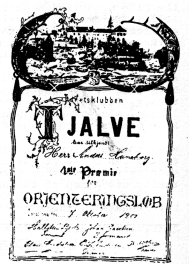
When Tjalve on 2 October 1898 held its second O run at Midtodden, Maridalsvannet, no participant reached the finish within the maximum time of 5-1/2 h. and in a new trial at Sandés a fortnight later, only ll men participated. In the corresponding race on 15 October 1899, 19 out of 24 applicants started, among which was one lieutenant (who won) and 8 cadets. Two other small O runs were organised that year in the Oslo area: by Baerums Verks SF, with 19 participants (who all reached the finish line in Lommedalen) and by Kristiania IF at Skjeggerud ("where the mist was so thick that horn blowers at the three control points had to signal every minute").33
In the first year of the 20th century, two public O events were arranged in Norway: one on 19 August 1900 by IK Viking in Bergen, with 14 competitors over a distance of 10 km and a winning time of 1.23.27, and the second on 7 October by Tjalve. For this fourth event by Tjalve, 39 young men applied but only 24 (among them 11 cadets) started from the farm Furuli close to the railway station Kolbotn, south of Oslo. Two control points and a distance of 9 km. Winner - Cadet Anders Haneborg, 1.15.55, whose prize diploma is still preserved. Noteworthy is that there was a compulsory pause of 5 minutes at one of the posts.34
During the next ten years, following O events in Norway are known:
In 1901, Tjalve at Nittedals station, distance approx. 12 km, 5-minute pause at the first of two control points, winner Chr. Gjanes, 1.04.30 (a remarkably short time - 5 min. 22-1/2 sec./km). Tjalve renewed its O event but in 1905 changed over to paper chases (perhaps because that was easier to arrange, but the paper slips hang rather openly, "which gave the run something of the nature of O").35
In 1902, O runs were organised by Røgdfoss Turnforening, 4.5 km, by Seljord IL, 4 km, by IF Tyr, Stordalen, by Ålesund, 5 km and by Nordfjords Sportassociation, 2 km (?), where among other things, a river had to be crossed. From the summer of 1903 there is a report on another O run by IK Viking, Bergen. All 13 participants reached the finish line - the best one, Mohn Handeland, Norønna, in 1.07.39. "viking has put this run in its annual program”.36 In 1908, O runs by Nittedals IF, Sotterud IF (with 15 participants), IL Frithiof in Veum, IF Tyr in Stordalen and Gardisternes IF, Oslo, with 54 participants - distance 10-11 km, two control points "where a report should be given", very difficult and hilly terrain (two times over - Gjellerésen), map and compass at the start and control points but forbidden in between. On 19 July 1908 the same club organised a patrol O with seven 3-man teams.27 In 1909 two small public O runs are reported and in 1910 seven Norwegian sport clubs organised O runs.
"For some reason or other, our feeble attempt died out..." 37
7.2 Sweden
In Sweden, the earliest O runs in the latter part of the 1890's were apparently reserved for officers and no civil club included the new sport in their programs before the turn of the century.
7.2.1 Introduction
A young engineer, Sigge Stenberg, 1876 – 1935, who in 1898 - as president of Allmdnna .Idrottsklubben in Stockholm38 - formed the first district alliance of sports in Sweden39 and became its president, wrote some articles in the leading Swedish sports paper in 1900-1901, after visiting Kristiania/Oslo, about the Norwegian O runs and urged Swedish sport clubs to include O in their activities.40 Stenberg described the Norwegian rules for O on skis (cp 10.1) and pointed out that those rules could be applied to O runs in the summer or to runs on foot during snow-poor winters as well.
7.2.2 The first events
The seeds Stenberg planted soon sprouted. Several athletic clubs in Stockholm became interested and following Stenberg's advice and instructions arranged long-distance runs in terrain with the help of maps, instead of the more usual country road runs. At that time, athletic fields with special running tracks were not common.
7.2.2.1 Sundbybergs IK
There was a very active club in one of Stockholm's northwestern suburbs, Sundbybergs IK (Sport Club), founded on 9 April 1893. At the suggestion of the then 24-year old Victor Dahl 41, the club decided to arrange an O-run on 24 February 1901. According to the club's books, 10 copies of sheet 75 of the official map of Stockholm were bought. They had the usual scale of 1:100 000. That map was drawn. during the years 1845-1866 and printed in 1873, i.e. it was already rather old.10
The competition was held on Sunday, 17 March 1901. The five participants started at 5-minute intervals at the Kratsboda farm at the southwestern edge of the populated area. The course ran 14 km over 4 controls which, even measured according to the standards at that time, were "extremely easy".42 Controls were located at Bromma Church, Vällingby farm, Spånga Church and Duvbo farm. At each control, information was given regarding the next one. The finish at Vireboda farm at the northwestern edge of the community was not marked on the map but everyone knew where it was located "because one of the club members lived there". The controls functioned mainly as landmarks to which the participants had to find their way as best they could.
The winner was the motivator himself, Victor Dahl (small silver medal). Time - 1 hour 35 min. 34 sec. which equals 6 min.49 sec. per kilometre. Not a bad result even though the terrain was quite open and there were many roads to run. Carl Fagerberg43 came in second in 1.40.34,
Dahl's comment was: "We didn't have a compass so it was necessary to not take any side detours and to take shortcuts where the terrain was not too muddy and wet. Those who had knowledge of the map had the best chance. I myself ran wrongly a couple of times but then got back on the right path again without having to ask the way! We wore the usual athletic suit but the local inhabitants had earlier declared that we were hopelessly crazy and so we were allowed to run loose anyway…"
On 13 October 1901 a new race was scheduled. However, one of the controllers forgot the name of the next control and could only "point the way we should run". That race was disqualified and probably was the world's first unsuccessful O-run! The second attempt at that run was held on 10 November and won by Carl Fagerberg in 1.35.06. The course setter, Victor Dahl, ran the same distance but outside the run in 1.48.35.
In spite of the fact that these first O-runs were so appreciated by the participants, the next one was not held until 19 years later when a new generation of orienteers took over. However, a run which could be compared to O was held during the summer of 1904 when the club's runners and bicyclists competed to see who could cover the distance of 7 km from the clubhouse in Lilla Alby to Nockeby Bridge without using the intermediate bridge over the Badllsta River. Victor Dahl's younger brother, Edward 44 swam over the river and came to the finish before all the bicyclists.45
7.2.2.2 AIK
Apparently the competitions in Sundbyberg did not arouse any greater interest because when Sigge Stenberg's AIK38 on 21 April 1901 arranged an O-run for its own members, the remark was made that, "this O-run is the first one to be held in Sweden.46 The conditions for this and following club runs were a little more advanced. The meeting place was announced a week ahead of time but in such a way that no inferences could be make about the start. The actual start position was announced first when everyone was assembled. The message at the start gave the controls which would be passed but the finish was revealed first at the last control. A card from each control had to be carried to the finish.47
The first run started at the old pontoon bridge from Ropsten to Lidingd. From there the course ran "over woods and hills" to Alkiste Bridge and from there to Jérva, with an obligatory pause of 5 minutes. The finish is not mentioned but the first person to arrive there was the first person to start - the 29-year-old Elis Juhlin, Jr.48 in 1.19.10. Second man was Birger Stenberg, younger brother of Sigge Stenberg in 1.33.20.
One observer remarked, "Sense of direction and ability to orient one's self on the map are the qualifications which are most important in these competitions".47 Within AIK interest for the new sport persisted - see 7.2.2.5.
7.2.2.3 IF Sleipner
A somewhat younger sport club in Stockholm - IF Sleipner - was established in 1897 by the then 17-year-old talented runner Kristian Hellström.49 As club secretary he, in April 1901, announced a public cross-country run ("Sleipner's terrain"),50 which was probably the first civilian competition of its kind in Sweden. Hellström was interested in Stenberg's ideas of a map cross-country instead of a paper chase and in April 1902 arranged an O-run open to all. In order to avoid the advantage of home territory, he set the location to the wilderness towards Saltsjöbaden on the premises of the Erstavik Estate. The well-known gymnastics and athletic leader, Victor Balck51 was one of the interested spectators. The only other recalled detail is, "The ground was covered with a great deal of snow and the runners lost their way and very nearly did not find their way back".52 It is probable that Balck could hardly consider O as an athletic form to be considered worthwhile. As far as can be determined, he never became engaged in that new people's sport.
7.2.2.4 Stockholm Sport Federation
In 1902 Stenberg had moved from Stockholm to Gothenburg but had already earlier withdrawn from the presidency of both AIK and Stockholm Sport Federation. However, his successors were just as active as he and made use of his ideas. On 20 July 1902 the board of the Athletic Association organised an "outing to Saltsjöbaden, in which many of the capital city's athletics-interested youth took part". The first event was an O-run of 10 km "in the difficult and hilly Erstavik woods". The winner was J. Nilsson, Östermalms IK, in 1.16.18.2/5. Afterwards everyone met on the athletic field around the federation flag and took part in a simple but impressive religious ceremony".53
In the autumn of that year 1902 Stockholms Athletic Association held another O-run with start and finish in the old Athletic Park (the site of the present Olympic Stadium, which was built in 1911-12). Controls were placed at Ballsta Bridge, Hagalund and Stocksunds Bridge. The race was "extremely difficult since the terrain at that time was like a forest primeval."54 A list of the results has to date not been found.
7.2.2.5 The first national O-run
AIK arranged a new race on Whitsunday 1902, together with IK Swithoid and with start and finish in Djursholm, a northeastern suburb of Stockholm. The course was_ 10 km long with controls at Kevinge farm (now a popular golf course) and at Ekeby. No-one had a compass, which resulted in several false runs. Elis Juhlin, Jr. added to his earlier victories. The weather was so bad that time too so that there were only 5 participants.55
Juhlin, who was once again president of AIK, arranged in August 1903 the distribution of a printed invitation "to your association to participate in AIK's first public O-run on Sunday, 20 September 1903, according to the propositions stated on the overleaf". In order to interest participants from outlaying areas as well, a special discount on railroad tickets had been arranged for the trip Malmö-Stockholm. Start and finish were the Athletic Park in Stockholm. Controls were placed in Sundbyberg and at Stocksunds Bridge - approx. 20 km. The winner was N. Runeborg, Östermalms IF, in 1.39.12.6. Only eight of the other results have been retained.56
7.2.3 The years 1904-1914
During the time preceding the start of the First World War in 1914, O-athletics occurred only sporadically. It was still included as an important part of military field tests (cp 5.2.1), was used as a form of training in some clubs and was included in the Scout program. Within the Stockholm Sport Federation, Where the president and board members changed often, football, bandy, athletic meets, swimming and skiing were most popular. No new federation-O was started.
7.2.3.1 The scouting movement
In 1909 Major Ebbe Lieberath - inspired by England - introduced . scouting in Sweden. The scouting movement adopted O as an excellent terrain practice, providing both excitement and practical value. The first systematic O education was prepared and easier competitions were arranged. Thus, the. historical statement from 1914:57
"Two boys, Arvid Sundelöf and Bertil Nordenfelt, in May this year ran in the same scout patrol in Uppsala. At that time, who could imagine that both would one day become two of the founders of the Swedish O-Association and leading men - Arvid as secretary and drafter of rules, Bertil as president and organiser"58 Regarding the first of a long series of O-runs after 65 years, the then 10-year-old Nordenfelt later stated:59
"It was mostly compass running from Bergsbrunnna Station, 5 km southwest to Kungshamn - just off the road to Stockholm. An easy match! After 4 hours(!) I reached the road but unfortunately 5 km too far southward... But during the night I dreamed - in spite of the unsuccessful beginning - of all the wonderful experiences which I later derived so much pleasure from during a long and happy O life..."
7.2.3.2 The Stockholm Amateur Club
Among the clubs which had O-runs as a variable part of their activities, the only records which have been found are from the Stockholm Amateur Association, established in 1890 as an athletic branch of the Stockholm Gymnastics Club. Gösta Drake, who introduced O as a branch in the military field tests (cp 5.2.1), probably introduced (as the Amateur Association's president from 1897-1906) the new sport in this civilian club. Included in the records, notices, maps, course descriptions and results lists which Ernst Killander (cp 8.1) collected during approximately 30 years,60 are maps with courses for the Amateur Association's races drawn in, but the first one dates from May 1907 and up to 1920. Killander himself participated in most of those races, often successfully. Below is a list:
1907 - 5 May — In the Nacka Woods from Drevinge via Älta to Nackanäs. Winner M. Bernström in 1.28.00.
1907 - 20 Nov. — Ormingelandet. Winner Victor von Feilitzen in 1.34.50.
1908 2 Mar. — Fagersjö-Huddinge. Winner Ernst Killander (no time stated). He also won the Stockholm Comrades' race three weeks later and an additional five in a short time.61
1908 - 3 May — Näsby via Gripsvall farm and Sätra Vicarage and back again. Winner S. Westerling in 1.13.30.
1908 - 4 Nov. — Dalen farm in the present community of Enskede, via Damtorpet, Pungpinan and Bandhagen and back again. Winner not stated.
1909 - 3 Mar. — Jädrfälla. The first night O in the world! Winner Victor von Feilitzen in 0.18.15, which indicates a very short stretch.
1909 - 2 May — From Tureberg to Vallabrink. Winner S. Westerling.
1910 - 8 May — Nacka Woods with start in Saltsjö-Duvnäs and finish at Nacka Inn, 13 km. Here for the first time simple terrain points were used at the controls.62
1910 - 13 Nov. — Danderyd-Edsberg-Nisby. Winner H. Friman in 1.03.13.
1911 - 7 May — Örby Woods 1912 - 10 Nov. Svalnäs-Sätra-Djursholm
1913 - 19 Oct. — Ösby-Rösjön-Danderyd
From the outside, O-sport during this period appeared to be highly anonymous.63
No records are available in Killander's archive covering the war years 1914-15, probably because Killander (as lieutenant in the Göta Life Guards) was in active military service. For the sake of coherence, those races which were known to have been arranged by the Amateur Association during and after the First World War are listed below:
1916 - 10 Sept. — Nacka Woods 1918 - 5 May Bogesundslandet
1919 - 10 Oct . — Brännkyrka
1919 - 24 Oct. — Södertörns Villastad
1919 - 6 Nov. — Tureberg-Rösjötorp-Näsby. Night competition! Winner H. Friman in 0.47.10. Ordinary flashlights were used for illumination.
1920 - 9 May Nacka Woods
7.2.3.3. The Crown Prince's Cup
The Swedish Crown Prince, later King Gustav VI Adolf, became interested in the usefulness of O within the army and established a wandering cup for the general staff and the Fourth Army Regiments, "in order to stimulate physical training in the officers’ corps".64 The yearly competition for this cup created great interest among officers in the Stockholm area. Even the first one - in 1908 - gathered 97 participants from 8 regiments. The winner was T Lundberg, Svea Artillery Regiment in 1.25.29, followed by 5 regimental comrades. However, during the following five years the races were dominated by the Svea Life Guards. The Crown Prince took part in the race in 1910 and came in in 38th place among more than 150 participants.65
7.2.3.4 A motion for a new, big O-run
In 1908 Ernst Killander {cp 8.1) became a member of the board of the Stockholm Sport Federation and the whole time up to 1935 carried out enormous and successful work - not least as president from 1917. In 1913 he put before the board a motion covering a big federative O on foot but the question was "postponed".66 His own words are:
"After Sweden's excellent participation in the 1912 Olympic Games, many more athletes tried cinder .tracks and other arenas. But in the year 1913 I could not contain myself any longer. I proposed - it is said - fantastic visions of O as the next big athletic branch in Sweden. I had been active myself in quite a few athletic forms but had not found any as entertaining, charming and character-building as O-sport. Why wouldn't it appeal to thousands of freedom-~seeking youth, considering that Sweden has the most wonderful areas in the world for just such a sport? Why should this game, played in woods and fields, giving so much boyish joy but still setting strict goals and offering so much in the way of education be reserved for only a small faction of military and professionals? No - it must be the property of the general public! And the Stockholm Sport Federation with its larger resources and experienced officials would be the logical organiser of a big publicity competition. I spoke warmly for this but it was like throwing water on a goose's back. The reasons for the postponement still ring in my years. O is a military athletic training, far too advanced to arouse any interest outside professional circles..." 67
Then came the war - creating other problems even for neutral Sweden.
7.2.4 The First World War and O-sport - 1914-1918
Practice and races in O became common within the army after the outbreak of war in 1914, especially for officers and from 1915 even for others.57
The officers quickly recognised the importance of O and the young recruits found O exercises both relaxing and enjoyable. They even arranged races during their free time. After the war, the knowledge of maps and compasses gained was carried over into civilian life. It was interesting and fun to find one's way in the wilderness. And so the wilderness romanticism was discovered. Wandering had become a necessity. This was a big step in the right direction. 67
7.2.4.1 Hellas
Following the pattern from military practice, two fellow-ex-soldiers from Göta Life Guards (where Ernst Killander was lieutenant) arranged each his gun club competition on 8 December 1918 - Sven Lindhagen68 for Hellas and Harald Nilsson for a small and short-lived club called Framåt (Forward). During their military service these two had become enthusiastic about O and decided to promote it in their civilian clubs.35
The competitions were completely separated and only the finish was common - the Hellas Club's special meeting place, Café Hvilan. Hellas had their start at Skanstull with controls at Källtorp and Brotorp, "an almost non-existent shack in the woods north of Skarpnäck, a fact which led to so much confusion that no-one found his way to it".69 The course ran 10 km, the map had the usual scale of 1:100 000, the terrain was quite well-known to the 6 participants, who all arrived at the finish. Winner was the club's athletic leader, Oscar Eriksson in 1.57.22, ahead of Gunnar Malmgvist in 1.58.56 and Sven Wallbom in 2.10.57.70 The latter mentioned was a well-known swim-promoter of the sport. The few "Forward" runners started somewhat to the west in Hägersten.
Later in that year 1918, IF Linnea held a smaller competition in Brännkyrka.60
It has later been stated that the Hellas race drew attention and became the ignitor of the spreading fire that started with the Stockholm “Sport Federation's big O-run in Saltsjöbaden in 1919. This may be true (see 8.2-4) but not even the organiser, Sven Lindhagen (who had at that time been active as a journalist in Idrottsbladet, the Athletic Newspaper) considered the event worth a notice in that publication.
8. Regeneration
The prerequisites for an explosive development of O-sport in Sweden existed at the end of the war in 1918: Maps (although they were old and faulty, cp 2.2), unlimited and unknown terrain, a newly awakened interest in nature and a widened understanding of O as a civilian branch of athletics.
8.1 Ernst Killander
The enthusiastic and energetic Ernst Killander became the rejuvenator. He has by all rights become known as "the father of O". Some personal data:71
Born on 10 March 1882 in Jönköping, died on 24 January 1958 in Stockholm. Second lieutenant in the Svea Life Guards in 1902, lieutenant in 1911, captain in 1920 and major in 1936. ADC at the Royal Castle from 1917 - 1940. Deputy Chief from 1908-1911 of the Athletic Park (which was established in 1896 and demolished in 1911. Member of the board of the Stockholm Sport Federation from 1908, president from 1917-1935. "Hövitsman" in "Skogskarlarnas klubb" from 1930. One of the founders of the Swedish O-Association in 1936. Also actively engaged in numerous other athletic and non-profit organisations, among others on the board of the Swedish Sport Federation. An idealist in soul but a real practitioner.
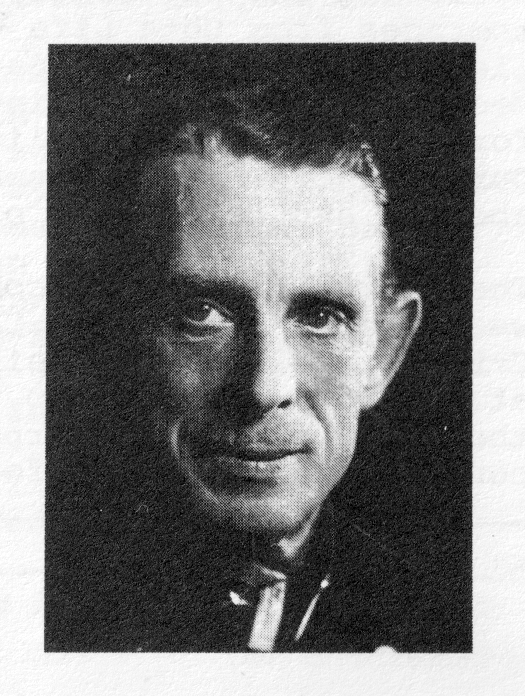
Ernst Killander, Idea-rich organiser, fund-raiser, friend of youth and president from 1917-1935 of the Stockholm Sport Federation.
8.2 The decision
In the beginning of 1919, Ernst Killander again put forth the question of a big O-run before the board of the Stockholm Sport Federation - this time as its president and with greater authority and greater preliminaries than in 1913 (cp 7.2.3.4). The results exceeded expectations. The postponed motion was carried without discussion and Killander was given the task of drawing up an outline for a big publicity competition - and to do so already that same spring!
"Was I happy? I could hardly believe it was true. But there was no reason for me to be proud because I had only been a small cog in the wheel. However, I was happy and proud to be chosen together with good comrades and colleagues to carry out the work laid out in the motion - perhaps the most important milestone in the history of O". 67
8.3 First event
The first "real", large competition in O was held on 25 March 1919. Of the 217 applicants, 155 gathered for the start at Igelboda Station close to Saltsjöbaden, 15 km southeast of Stockholm and at the northern end of Erstavik Woods in Nacka - just beside the hill where the steel statue (erected in 1975) stands as a memorial to this first event (cp note 3). It was a strange collection of people. Bakery workers, stone cutters, students, promising military men, department heads, bank presidents - all with the same eagerness, the same expectations. Seldom had an athletic meet been held in so informal and democratic form as this one. The clothing worn should be mentioned. "Come as you are" was the slogan, more precisely formulated as follows: head-ware, jacket, vest, shirt, long or short trousers (with the latter either long stockings or leg wrapping), leather shoes with a strap over the ankles but without spikes or knobs in soles and heels!
There was still snow in the woods and to make things even worse, there had been a snowfall the day before. The organisers were worried. Would there be beaten tracks from start to finish which would give complete outsiders a chance? No need to worry. The most qualified won anyway.
The course was the same for all three classes (86 seniors, 42 old boys and 27 military) and was 12 km long. The three controls as well as the finish were given in writing for each stretch: the small marsh Knipträdsk, Tenntorp farm, Kolarängen farm and the finish at Nackanäs Inn. Killander himself was both course setter and control marker; the flags were made of bright red cloth squares.
Participants started with l-minute intervals, the military at 10:00 a.m., the seniors at 10:45 a.m. and the old-boys at 1:00 p.m. The whole race was not completed until late afternoon.
First to the finish was No. 4, Bertil Uggla of IFK Stockholm, who won a bronze medal for high-jump in the 1912 Olympic Games and a bronze medal in modern pentathlon in 1924. He later became a colonel. With his time of 1.29.42 he won the military class. Best among the seniors was the well-known skier, Gurra Wahlgren, Djursholm, in 1.27.19. But, even faster was Djurgården's skiing old-boy, 0.B. Hansson, a 32-year-old carpenter who had his roots in northern Sweden. His time of 1.25.39 - in other words a kilometre time of 7 min. 8 sec. - must be considered very good, considering the difficult terrain and all the snow.72
8.4 Repercussions
This competition aroused unexpectedly great interest in the Swedish press. All of the large Stockholm newspapers printed detailed accounts, Praising the competition, its organisers and its final success.67
The whole first page of Idrottsbladet (Athletic Newspaper) was devoted to a commentary, with maps and pictures of the event. Sven Lindhagen, who placed 32nd in the senior class with a time of 2.00.27, wrote a comprehensive analysis of the course, controls, the many possible routes and how the best runners ran. "The competition was a great success as far as arrangements, participants and results are concerned".72
Thirty years later Ernst Killander wrote, "It was an undescribable pleasure to see one after another of the runners cross the finish, soaked to the skin and exhausted after all the trials but in spite of that so happy and in such good humour. Of course, we who had made the arrangements learned a great deal and had found a solid ground on which we could build further”.67
As late as 1952 he wrote, "No other competition had made such an indelible impression on me. Today one can perhaps laugh at it but it was actually an experiment which many looked upon with mistrust. How warming it was then when one heard from all quarters - Let's do this again!" 73
9. The avalanche was on its way
The success of the competition in Saltsjöbaden was so obvious that Ernst Killander and his federation in Stockholm sent invitations already on 2 November 1919 to another big competition. Two old-boy classes had now been established - one for participants born at the latest in 1880 and the other class born from 1881-1887. Approximately 200 out of 290 applicants started from Huddinge, southwest of Stockholm. The old-boys' course was 9.5 km via Fagersjö and Bandhagen, the seniors' and military was 13.5 km via Nytorp-Stuvsta-Fagersjo and Bandhagen - all with the same finish in Enskede. The longer course was won by Knut Mannheim, Djursholm, in 1.41.44.1. Fastest of the old-boys was Kalle Sundholm, Djurgården in 1.26.24.5. 74
In the autumn of 1919 Uppland Sports Federation arranged a longer competition at Alsike with finish in Flottsund. Among the 100 participants, Axel "Old Man" Lenngvist from IF Thor, won an easy victory. He later became historian and board member of the Swedish O-Association.57
Ernst Killander was asked to work out more detailed competition rules71 which were later approved by the Swedish Athletic Association, which organisation up to 1938 administered the quickly growing sport.
9.1 Sweden 1920-1950
In 1920 the avalanche stretched further out into Sweden. Athletic associations in Dalecarlia, Gothenburg, etc. arranged their own competitions and O was included in the programs of many clubs. Talented course setters improved the art of using maps and terrains and in inventing interesting problems for the runners to solve. Foremost of these can be mentioned: Olle Ekblom can be mentioned as teacher for several generations of new orienteers at the College of Forestry in Garpenberg, as well as the almost legendary "Moss"-Erik Johansson, Gothenburg.
During the 1920's all the basic principles of competitive O, as it is known today, were laid down, governing types of courses, control stations, age groups and organisations.
In 1921 Sven Lindhagen68 and several of his fellow board members in the Hellas Club took the initiative for the first relay-0 on foot. Thirty-two 3-man teams started a very exacting course, with start at Alby in Tyresö and finish in Enskede. Winners were J. Jonsson, A. Eriksson and H. Schuster of Fredrikshofs Sport Club. The expenses were however too great for Hellas and in 1923 the arrangements were taken over by IFK Stockholm, whose leader ~ Richard Gison Sjöberg - personally assumed the responsibility for the costs!75
By 1922 the individual O-run had become so established that the Stockholm clubs could held their first official district championship. The winner was Gunnar Wahlgren, IFK Djursholm. Already in 1924 many of the 22 districts followed suit. Relay-0O got is own district championship in 1928 - also that arranged by Hellas.
The first night-O was held on 2 December 1922 on Värmdölandet, just east of Stockholm and arranged by the Stockholm Athletic Association. The course measured 7 km as the bird flies, with start from Hasseludden and finish at Björknäs. Of the 187 who started, Manne Dryssen of IFK Stockholm came in winner in 56.33.3.53
In 1926 the first elite national competition was held. The large and very O-interested Stockholm newspaper, Dagens Nyheter (Daily News) invited all of the country's district champions to a competition in the vicinity of Dalard, south of Stockholm, where the terrain was new to everyone. Birger Nylund, Djurgården, was course setter. The winner was Stockholm's legendary Folke Thörn, before Dalecarlia's Herbert Lindgvist.
A special ladies' class was introduced. It has not been possible to determine the exact date of this competition.
In the spring of 1929 the KFUM (YMCA) in Gothenburg arranged its first 3-mile (1 Swedish mile = 10 km) competition - a tradition that is still alive.
Orienteers and their clubs started to insist with vigour on having their own special association and having Swedish championships both as individuals and in relay-O. The Swedish O-Association (founded in 1936) first in 1938 became an official member of the Swedish Sport Federation. The first individual championship was held in 1935 in Skinnskatteberg with Olle Ekblom as course setter and Arvid Kjellström from Stigfinnarna (the Pathfinders) as the first Swedish O champion. The first relay-O championship came as late as 1938 when IFK in Boris with Gunnar Larsson, Folke Särén and E.O. Hultman won on | "Moss"-Erik's ingenious course.
The first Swedish ladies' championship race was held in 1941 (winner Eva Zettergren-Weineby, Nynäshamn) and first relay-O in 1948 (winner IFK Enskede with Harriet Erikson, Eva Holm and Maud Wirstam-Björkman). Finally, the juniors got their district championship start in 1940 and Swedish championship in 1948.
9.2 The Nordic countries
Through the good contacts with neighbouring countries of Finland and Norway, the new O-sport spread to those countries as well - in 1923 through the Swedish athletic instructor, Gösse Holmér and the Finnish leader, Leo Löf. O was re-introduced into Norway in 1925 through the Norwegian sports journalist, Per Chr. Andersen, who with three of his colleagues had studied this new phenomenon in Stockholm. On 25 October 1925 the first O-run in Norway in "modern times" was held. The event was held on Huurum-landet in pouring rain. Winner - T. Krogvik. During the middle 1930's O established itself in Denmark as well,76 mainly through the Swede, Gösta Wijkman's, popularisation trip and through the cooperation of Olaf Andersen, later the Danish O-Association's first president. In all the four Nordic countries the young O-sport really started to mushroom.
In 1932 the first team competition between Sweden and Norway took place just north of Oslo, in very rough terrain. This was, without doubt, the first international O-run in history. Individual winner was the Swede Albin Lindholm. In 1935 team competition between Sweden and Finland was held outside Helsinki, with Sweden as winner. In 1938 the time was ripe for the first 3-nation competition outside Katrineholm, Sweden. Sweden won over Norway and Finland.
Finland (1935) and Norway (1937) and Denmark (1942) organised their national championships. After the Second World War they also formed their own O-Associations.
In 1946 another 3-nation competition was held, this time outside Bords, Sweden, with the Swedish 10-man team as winner ahead of the Finnish and Norwegian teams. The following year Denmark also participated, in Hönefoss, Norway. Norway came in first, Sweden second and Finland third.
In Borås in 1946 the first nucleus of an international organization was formed through a Nordic Committee (NORD) to cooperate on common matters regarding rules, course setting, teaching methods and spreading O internationally.
In fact, the O-sport blossomed in all of the Nordic countries and soon scattered its seeds over the whole world.
9.3 International O
Different forms of O soon began to spring up in other European countries. "Back-to-nature" movements quite naturally furthered the interest in this sport as a key to fuller enjoyment of outdoor life.
9.3.1 Switzerland
O-sport in Switzerland got a stronghold and the first open O-event was held in 1933 in the Zurich area. In the 1940's, events outside Zurich drew as many as a thousand participants in team competitions. In 1950 the first club competition between Swiss and Swedish O was held, first in the Swedish mountains in Jämtland and then in Switzerland. Gunvald Hikanson, Stockholm, was the initiator. In 1957 the Swedish ladies won but the Swedish men lost in an unofficial national competition event. The Scandinavian orienteers' domination was being threatened....
9.3.2 Other European countries
The following data can be mentioned with regard to international development:77
1933 — First O-competition was held in Hungary
1933 — First O-event took place in the USSR
1950 — First O-event in Czechoslovakia
1953 — First DDR championships in team ski-O (cp 10.3)
1953 — An O-event was organised in Yugoslavia
1955 — O was introduced in Bulgaria
1958 — A Swedish pioneer troop was invited to Bulgaria
1958 — A series of club competitions, arranged between Stockholms OK (O Club), led by Baron Gösta Lagerfelt, and several other clubs in various Western European countries took place during the closest following years, sewing new O seeds. Thus, the sport was introduced in West Germany in 1958, in Great Britain in 1959 and in France in 1965.
1960 — Swedish victories during an official visit in Czechoslovakia.
1961 — Another Swedish O enthusiast, P.O. Bengtsson, started a new series of "missionary trips" to many European countries, together with voluntary orienteers from all of Scandinavia.
1963 — First USSR championships
1963 — First Swedish team to win the Balaton trophy in Hungary
1966 — Formation of the British O-Federation (BOF) 1970 The French O-Association was formed
1979 — One single, consolidated O-association formed in Switzerland
9.3.3 Overseas
Because of limited space, only a few facts from a multitude of information can be given here: 77
1946 — At the initiative of the Swedish champion orienteer, Bjbrn Kjellström (cp 2.3), the first competition in the United States was held in the Indiana Dunes State Park.
1948 — O was introduced by Björn KjellstrdSm to the Canadians, outside Toronto and Montreal.
1967 — The Israeli O-Association was formed 1967 Formation of the Canadian O-Federation 1968 O was introduced in Japan by Tord Kjellström
1968 — First Canadian championships held in Gatineau Park outside Ottawa.
1969 — The Japanese O-Federation (JOC) was formed
1969 — Tom Andrews and Peter Wills-Cook, both residents of Australia, started O-sport on this continent
1970 —The O-Association of Australia was formed
1970 — Gordon Pirie, the ex-Olympic runner from England, ) introduced O to New Zealand
1970 — First U.S. championships at Carbondale, Ill.
1971 — Founding of the U.S. O-Association
1971 — First North American championships at Quantico, Va. 1971 First championships in Australia and New Zealand
1976 — The Quebec 5-day meet drew 1500 entries (among them 800 Swedish guests)
Most of the credit for spreading the O-sport on an international level is given to the Swedish 0-Vikings, as they have been called. Such Viking trips, not only around Europe but also to North America and Japan, Australia, New Zealand and (in 1978) around the world have been made by both individuals and groups.
10. Ski-orienteering
O can, as stated in note 1, also be done on skis. This type is nearly as old as O on foot, although not so widespread.
10.1 Norway
The first documentation of O on skis is found in Norway.33 On 11 March 189% an O-race on skis was arranged by the Norwegian Cadet School in Oslo. Place: Baerum, air distance 6.3 km. Winner among 27 was Sergeant Middelfart (no time noted).
A fortnight later the Trondheim Ski Club organised what appears to be the first non-military ski-O on 26 March (after an unsuccessful trial in February).78 Map and compass were specified but two missed the map on the way. Air distance 20 km. Winner Aasmund Sandok, the Technicians' Club, time "2.30.20. No report as to number of participants or start method.
10.2 Sweden
As stated above (5.2.1), the idea of ski-O came to the fore in Sweden too in 1899, through Captain Heijkenskjöld. As president of "Skidfrämjandet" (the Swedish Association for the Promotion of Skiing), he was the initiator of the first relay O-race on skis, held on 4 March 1900. The route was Bollnis-Hudiksvall-Sundsvall-Hirnösand - a distance of 175 km.
Since then, such relay O-races have been held annually in Sweden (from 1910 ranked with the official Swedish championships) but in more recent years more closely related to what we now call O.
10.3 Other countries
Individual ski-O has become a popular sport also in Finland, France, Great Britain, most of the Eastern European states, in Australia, Japan, Canada and the U.S.A. In 1948 ski-0O started outside Turin, N.Y., where it remained active for several years. In 1953 the first DDR championships in team ski-O took place. The first IOF ski-O trophy competition was held in Bulgaria in 1972.
Strangely enough, ski-O has not taken root in Norway, although this country could have organised ski-O as part of the Olympic Winter Games in 1952. But the Norwegians will come around, too!
11. International organisation
When the Scandinavian orienteers, exploring the. possibilities of an international exchange in competitions, found that there were some differences in the general character of the sport and its organisation in several countries, they felt an urgent need to consolidate the basic principles and rules for the sport, in particular for international competitions.
11.1 The Sandviken Conference in 1959
In contact with NORD, the Nordic Committee formed in 1946 (cp 9.2), the Swedish O-Association initiated the first international conference in Sandviken, Sweden in May 1959. Eleven nations sent delegates. Agreement was reached to follow in principle the Nordic ideas on the basic rules for international competitions.
More and more international events between the Scandinavian countries and the European Continent took place. In 1960 an international meet (NORD-race) was held outside Stockholm, with 7 nations participating - Sweden, Norway, Finland, Denmark, Switzerland, East Germany and West Germany.
This event was used as a means of introducing the Scandinavian type of O to other countries, thereby taking the first step towards a coordination of the different varieties of O which had started to develop, especially in the Eastern European countries.
11.2 International O-Federation
Scandinavian orienteers felt that the time had come to get O more firmly organised internationally.
In 1961 they called a meeting in Copenhagen, Denmark, for the formation of the International Orienteering Federation (IOF). Ten nations met and joined the Federation - Sweden, Norway, Finland, Denmark, Switzerland, Hungary, Czechoslovakia, Bulgaria, West Germany and East Germany. A Swede, Erik
Tobe (M.P.) was elected first president and remained in that office until 1975. He had been an active orienteer himself and was - just as the author - a member of a team which won the first district championship in relay-0 in Uppsala, Sweden in 1927. Dr. Inga Lowdin was General Secretary until 1975.
The formation of the IOF helped international O to progress more rapidly. Already in 1962 the first European championships were organised in Löten, Norway, followed by the second ones in 1964 in Le Brassus, Switzerland, with 11 nations participating. These meets were upgraded to world championships in 1966 when they were held in Finland. Eleven nations, represented by 57 men and 35 ladies, participated. (Participation by 6 men and 4 ladies was allowed.)
The IOF can now (1979) boast of 23 member nations pursuing O in their respective countries according to the same pattern and rules. The member nations are Australia, Austria, Belgium, Bulgaria, Canada, Czechoslovakia, Denmark, East Germany, Finland, France, Great Britain, Hungary, Ireland, Israel, Japan, Luxembourg, New Zealand, Norway, Poland, Sweden, Switzerland, the United States and West Germany.
The IOF is organised with special committees handling the member nations' interests in coordinating future work for O. Most important for the future growth of O as an international sport are the Education and Promotion Committee (APK), the Map Committee (KK) and the Press Committee (PK). The APK is trying to assist new countries in the introduction of O and is also exploring the possibilities of spreading O into areas where it is still not known. The KK is supervising the development of O maps and works out the rules for the making of O maps (cp 2.2).
12. The future
Finally: O is quickly developing into a fascinating sport for all and a salubrious leisure-time activity all over the world.
_____________________________________________
Thanks!
I would like to thank the following institutions for their valuable cooperation in the collecting of information which laid the foundation for this history of the birth of O and its development:
GIH Library, Stockholm Royal War Archives, Stockholm Stockholm City Archives
The Swedish Sport Federation Library, Farsta The University Library, Oslo
as well as the following individuals for their inspiration and valuable information:
Hasse Hedlund, Enskede, Sweden
Lars I. Hansson, Bandhagen, Sweden
Björn Kjellström, Pound Ridge, N.Y., USA Christer Palm, Lidingé, Sweden Kristoffer Staver, Sandvika, Norway Jakob Vaage, Bekkestua, Norway
BERTIL NORDENFELT
_______________________________________________
FOOTNOTES
1 — Orienteering is the art of finding one's way through an unknown area, usually woody terrain, with the aid of map and compass. Orienteering can be practised on foot but also on skis or bicycles, in canoes and even by car. Orienteering is an outdoor recreation for physical and psychological exercise and also a competitive sport on the world championship level.
2 — "Orienteering' is a word coined from the Scandinavian "orientering" and the German "Orientierung" to identify an outdoor program based on the use of maps and compass. The English spelling "orienteering" was coined in 1946 by the Swedish-born champion orienteer, Björn Kjellström, Pound Ridge, N.Y. In this paper, the word "orienteering" will be abbreviated to only "O”.
3 — A statue of stainless steel was dedicated at the 8th Congress of IOF on 4 July 1975 by the Swedish King Carl XVI Gustaf at Saltsjöbaden, outside Stockholm, which community was considered to be the location of the first official race on 25 March 1919. The statue revolves with the wind to all the compass points in the world where orienteering is now practised.
4 — Focus, Sporten, 1, p. 89, Stockholm 1966
5 — IOF report, 1977:2
6 — Svensk Uppslagsbok, 15, col. 978, Malmö 1950.
7 — Jan Martin Larsen in "25 år, Norges Orienteringsforbund, 1945-1970", Olso 1970.
8 — Skärmen, Orienterarnas årsbok 1967, p 144, Stockholm 1967.
9 — IOF report 1975:2. Skärmen, Orienterarnas årsbok 1976, p 142, Stockholm 1976.
10 — Christer Palm in "Sveriges Kartläggning", the ten-year book of Kartografiska Sädllskapet, Stockholm 1968. Anders Timner in same, Stockholm 1978.
W.P. Adams, Trent University, Peterborough: "Geography and Orienteering", in the Journal of Geography, vel. LXXT, No. 8/1972
11 — Latest research work indicates that the magnetic needle was known already approximately 6,000 years ago, in the Mexican Olmec Culture. Science, Vol. 189, p. 753 ff, U.S.A., September 1975.
12 — Bertil Nordenfelt: Highlights in the History of Orienteering, Canada 1971.
13 — Gordon Pirie: The Challenge of Orienteering, p. 18, London 1966.
14 — J.E. Dixon in "Ny Tidning för Idrott", 16/1900, p. 132-133, Stockholm.
15 — Viktor G. Balck in "Tidning for Idrott", 19/1883, p. 145, Stockholm.
16 — Nya Hernösands Posten, Sept. 1883.
17 — Johann Christian Friedrich Guts Muths: "Turnbuch für die Söhne des Vaterlandes", p. 272 ff., Frankfurt am Main 1817.
18 — Ordningsstadga 4, oktober 1840 f&r Kungl. Krigsakademien, Karlberg, Stockholm.
19 — Sigvard Ekstrand: Karlberg 1792-193, Kungl. Krigsakademiens och Krigsskolans historia, p. 94 ff, Stockholm 1937.
20 — The author has not yet found any proof of the use of the world "orientering" in the archives of the Military Academy at Karlbergs Castle and cannot check whether the late historian, Major Fkstrand18 did. Perhaps Major Ekstrand himself, when writing his history, preferred the current "orientering" as a term for the scout practice with map and compass that certainly occurred in the education at the Academy. On the other hand, the world "opjeptering” was noted both in Sweden and in Norway seven years later (1895 24, 27) and might have come into use already in 1888 - at least in military circles.
21 — Nordisk Familjeboks Sportlexikon, 5, p. 846, Stockholm 1943.
22 — Tidning för Idrott 1893, No. 23 and 25; 1894, No. 26, published by Viktor G. Balck, Stockholm51. Results were based not only on the time used to cover the set distance but also on the participant's verbal report and physical condition. The same kind of messenger competition was repeated 1894-1896, the two last years also on bicycles. The "unknown areas" were situated quite outside the drill grounds where the report was submitted.
23 — Focus, Sporten, 1, p. 257, Stockholm 1966.
24 — Olof Bengtsson, in the anniversary book, "Svensk Militér Idrott 1909-1959", p, 119, ff, Karlskrona 1960. From 1895, O (on foot or on skis) and map reading (landmark hunt) have been two main branches of the "field tests" that today are still organised in Sweden, locally and nationally (from 1941 open for civilians as well and ranked with the official Swedish champion-— ships). Since 1909, "field tests" are managed by Sveriges Militära Idrottsförbund (SMI = Swedish Military Sports Association) which, for instance, in 1914 ("Baltic Games" in Malmö) and 1916 ("Swedish Games" in Stockholm) organised national "field tests" including many branches (0 run of 9 km, cross-country 7 km, swimming in uniform, shooting, horseback riding, bayonet fencing, etc.). These were much discussed because of their high degree of difficulty.
25 — Nordisk Familjeboks Sportlexikon, 5, p. 847-848.
26 — Svea Lifgardes Idrottsklubbs styrelseprotokoll 1895-05-09: "The Lieutenants Plomgren, Dreke and Sandstrdm were commissioned to prepare the field tests on June 30th". (Unpublished proceedings of Svea Lifgarde. )
27 — Centralforeningen for Udbredelse af Legemsgvelser og Vabenbrug, Aarsberetning 1861-1915, Kristiania/Oslo.
Norsk Idraetsblad 1881-1915, Kristiania/Oslo.
28 — Bergens Aftenblad No. 5975, Friday 15 June 1897. Some information (Norsk Idraetsblad 25 November 1897, Kristiania/Oslo and Skärmen 1968, p. 12, Stockholm) state the date of this event to be "Sunday, May 13th", but the 13th was a Thursday and the correct date is as above — 20 June. (Calendar for year 1897, Stockholm 1896.)
29 — Unpublished minutes of the IF Tjalve, Kristiania/Oslo, 1890-1910, through Kristoffer Staver, Sandvika, Norway, 1979.
30 — Norsk Idraetsblad 1897, Kristiania/Oslo, through Jakob Vaage, Bekkestua, Norway. Idrettsforeningen Ørnulf gjennom 50 år, 1893-1943, p. 77, Oslo 1946.
31 — Norsk Geografisk Opmåling, Oslo, through Kristoffer Staver, Sandvika, Norway 1979.
32 — Personal information in 1979 from Kristoffer Staver, Sandvika, Norway: "During the 1940's, the club premises were occupied by the Nazis and all members withdrew except two - father and son - who were appointed managers. After them that very minute of 1897 is missing – may be because their name was just Finnerud, the same as one of the check-points?”
33 — Norsk Idraetsblad 1898-1899, Kristiania/Oslo, through Jakob Vaage, Bekkestua, Norway.
34 — Skärmen, Orienterarnas årsbok 1976, P. 12, Stockholm.
35 — Gösta Wijkman in "Svenska Folkrörelser, p. 152, Stockholm 1939.
36 — Norsk Idraetsblad 1903, Kristiania/Oslo, through Jakob Vaage, Bekkestua, Norway.
37 — Knut Berglia in "25 år, Norges Orienteringsforbund 1945-1970", p. 6, Oslo 1970.
38 "ATK" (= Public Athletic Club}, founded in 1891, is still one of Sweden's most famous sport clubs. At present, especially important are the: football and ice hockey teams. See also 7.2.2.2.
39 — Stockholms Idrottsförbund, (Stockholm Sport Federation) which later played an important part in the rise of modern O. See also 7.2.2.4 and 8.2-4.
40 — Stockholms Idrottsliv 1898-1923, p. 204, Stockholm 1923. Nordiskt Idrottslif No. 46 and 49/1900 and No. 2/1901, Stockholm. In this paper, Stenberg wrote: "...in order to recognise the importance of those qualifications: to be able to take one's bearing, to find one's position, to choose the best way and to judge the terrain and to fulfil the claims made on young people in the field".
41 — Victor Dahl, 1876-1956, later permanent member of Sundbyberg IK, member of the board of Stockholms Sports Federation 1909, etc. Construction engineer, together with his older brother, Frithiof, contractor, supervised the erection in 1911-1923 of the famous Stockholm City Hall (architect Ragnar Östberg).
42 — K.A. Rabén in Skärmen, orienteers' year book 1940-41, p.7, Stockholm 1941.
Sigge Stenberg in Nordiskt Idrottslif No. 14/1901, p. 139, Stockholm.
43 — Carl Fagerberg, 1878-1948). Studied at the Academy of Art in Stockholm, received a Jemny Lind scholarship in Paris. Became one of that period's most appreciated Swedish sculptors specialising in animal and sport motives. His sculptures "Marathon Runner" and "Shot-putter" are displayed in the entrance to the Stockholm Stadium, which was erected for the 1912 Olympic Games. (Svensk Uppslagsbok 9, p. 90, Malmö 1948)
44 — Edward Dahl, 1886-1961, bronze medal winner in running of 5 English miles in the 1906 Olympic Games in Athens.
45 — Arthur Lidstrdém in "Sundbybergs IK 1893-1943", p, 33, Sundbyberg 1943.
46 — Svenska Dagbladet 1901-04-21, Stockholm.
47 — Nordisk Idrottslif No. 17/1901, p. 164, Stockholm.
48 — Elis Juhlin, Jr., 1871-1950, president of AIK 1893-1905 and 1912-1920. Treasurer and driving force in the Stockholm Athletic Association from 1902-1924 and board member of the National Federations for Athletics, Skiing and Football. Office manager by profession. (Stockholms Idrottsliv, p. 296, Stockholm 1923.)
49 — Kristian Hellström, 1880-1946. Secretary of IF Sleipner 1897-1903 and from 1924-1932! on unusual busy bee". The initiator of Sleipners' terrain 1901 (cp 50 / and of Svenska Dagbladet's relay race in 1913, both events still (1979) going strong. General Secretary of the 1912 Olympic Games in Stockholm. Sweden's foremost middle-distance runner 1900-1910, Scandinavian champion in 500, 1500 and 10,000 meters in 1902, bronze medal winner in 1500 m at the 1906 Olympic Games in Athens. Won L Swedish championships and sat 19 Swedish records. Businessman by profession. (Svensk Uppslagsbok 13, p. 142, Malmö 1949.)
50 — In the invitation it was stated that "the competition is intended to sharpen the skills of 0 and develop skill in running through unbeaten ground". (Nordiskt Idrottslif No. 13/1901, states that Stockholmers are "lucky to own the most ideal terrain, just at the borders of their own city") The first competition was won by Hellström in 21 min. 4.4 sec., among TT participants over the 5,700 m long course. (Focus, Sporten 1, p. 572, Stockholm 1966.) In September 1901 Örgryte Idrottssällskap (Sport Society) in Gothenburg arranged a "paper chase on foot" from Balders Hage to Dellsjön and back. (Nordiskt Idrottslif No. 13/1901), a popular event which was repeated many times and which in 1903 was falsely interpreted as an O-run. In that case, it would have been the first one in western Sweden. (Skärmen, the orienteers' yearbook 1968, p.9).
51 — Victor G. Balck, 1844-1928, "the father of Swedish athletics". Established Stockholms Gymnastic Club in 1875 and as teacher and principal at the Royal Central Gymnastics Institute (GCI) in Stockholm was the driving force for the development of voluntary gymnastics both within Sweden and abroad. Organised modern athletics in Sweden and held important positions within several Swedish and international athletic organisations, among others within the Swedish Sport Federation and the International Olympic Committee (IOC). Became military officer in 1866 and reached major general rank in 1914. (Svensk Uppslagsbok 2, p. 1173, Malmö 1947, Focus, Sporten 1, p. 563, Stockholm 1966).
52 — Gösta Wijkman in "Svenska Folkrdörelser", p. 152, Stockholm 1939.
53 — Stockholms Idrottsliv under 25 år, p. 204, Stockholm 1923. Nordiskt Idrottslif No. 29/1902, Stockholm.
54 — Lorentz "Max-Emile” Göranson in "VAr Idrott", p. 373, Stockholm, 1930.
55 — Nordiskt Idrottslif No. 20/1902, Stockholm 1902.
56 — Invitation 20 August 1903. Fredrikshofs IF's archives, Stockholm. Nordiskt Idrottslif No. 39/1903, Stockholm. "Skärmen, orienteers' yearbook 1968% p. 9, Stockholm 1968.
57 — Axel Lenngvist: Orienteringsidrottens historia, p. 19 (unpublished documents, Swedish O-Association 1947).
58 — The Scout patrol was Örnen in the third section of Uppsala Riddarpojkar (YMCA's Scout Troup in Uppsala) whose chief was Lieutenant Sven Sondén, enthusiastic orienteer and later gymnastics teacher in Sigtuna. Arvid Sundelöf, 1898-1950, forester who became academic O champion in Stockholm in 1921, won the team championship in Stockholm in 1926, the old-boys district championship in 1930 and won the old-boys class in the first in official Swedish championships at Dådran in Dalecarlia in 1931. National historian of "Skogskarlarnas Klubb" from 1937. "A purposeful, active athletic leader, becomingly modest but very efficient. (Ingvar Gustafsson in "Svenska Folkrörelser”, p. 666, Stockholm 1939).
Regarding the Scout movement as a recruiting element within O leadership, the four presidents of the Swedish O-Association (Malcolm Murray 1936-60, Bertil Nordenfelt 1961-70, Bengt Saltin 1971-75 and Ingvar Rittsél 1976-) can be mentioned. They started in O as Scouts, as did the Association's secretary after Sundelöf, Hasse Hedlund. (Skärmen, the orienteers' yearbook 1938-1979). Also "the father of O", Ernst Killander (see 8.1) held O-runs with Scouts during the years 1909-1911. (Skärmen 1952, p. 16).
59 — Bertil Nordenfelt in "Idrottskamrater Minns" (Athletic comrades reminisce), an anniversary present at the Swedish Sport Federation's 75th anniversary celebration in 1978, p. 48. Stockholm 1978.
60 — Ernst Killander's collection in Stockholm Sport Federation archives, kept in the Stockholm City Archives.
61 — Idrottsföreningen Kamraterna (Athletic Association Comrades) was founded among the readers of the youth newspaper "Kamraten" (Comrade), Mainly high school youth, with their first local chapter formed in 1895 in Stockholm. This association, to which Killander also belonged, organised several O-runs at the beginning of the century, of which Killander won six. (Axel Lenngvist: Orienteringsidrottens historia, p.18. Unpublished records, Swedish O-Association 1947).
62 — The following statement concerns this competition. "Since the participants were bothered by various difficulties in the form of waterways, etc., they headed for the city (Stockholm) where they changed clothes, succeeded in finding the finish and arrived there with dry clothes and good appetite". (Folke Franzon: '"Vägen till VM, i Skärmen, the orienteers' yearbook 1968, p. 9. Stockholm 1968).
63 — "O-runs didn't attract many during this period. There was no athletic press and the daily newspapers, from which we have later had so much invaluable support, were not in the least interested in this branch - hardly in sports in general." (Ernst Killander in "Hur vi började" (How we started) in “The Book about O”, p. 60. Uppsala 1948).
64 — Bertil Reuterswärd in "Kungl. Livegarde historia 1719-1976" (Royal Lifeguard History 1719-1976), p. 682. Stockholm 1976. ’
Lorentz "Max-Emile" Göranson in "Vir Idrott" (Our Athletics), p. 37h. Stockholm 1930.
65 — Nordisk Familjeboks Sportlexikon 5, p. 847. Stockholm 1943.
66 — Skärmen, orienteers' yearbook 1938, p.30. Ditto 1952, p. 16. Stockholm.
67 — Ernst Killander: "Hur vi började" in “The Book about O”, p. 63, 6h. Uppsala 1948.
68 — Sven Lindhagen, 1896-1969, one of Sweden's most knowledgeable and reliable sport journalists, mainly active in Idrottsbladet and at Sveriges Radio (the Swedish Broadcasting Corp.). As leader, active in the swimming and athletic club Hellas (est. 1899) and other organisations in Stockholm.
69 — Later renovated and enlarged and used as club facilities by Skogsluffarnas 0K, Stockholm. ’
70 — Herbert Lindell in "Budkavlen, Hellasorienterarnas tidning" No. 3/1978 and during private conversations in 1979. Lindell, born 1893, was secretary of Hellas from 1915-1920 and as such an official at competitions.
71 — Jan Lindroth in Svenskt Biografiskt Lexikon, band XXI. Stockholm 1975.
72 — Idrottsbladet 1919-03-28. Stockholm.
73 — Skärmen, the orienteers' yearbook 1952, p. 17. Stockholm 1952.
74 — Stockholms Idrottsliv under 25 år, p. 205. Stockholm 1923.
75 — Nordisk Familjeboks Sportlexikon 2, p. 30. Stockholm 1939.
76 — A statement in Dansk Sportsleksikon II, p. 287 (Copenhagen 1945). that the first O-run in Denmark was arranged already on 6 November 1898 by Arbejdernes Idraetsklubb (the Workers' Athletic Club) is misleading. It concerns what was primarily a road run from Damhuskroen to Bagsvaerd Kro. On the other hand, from 1906 the long-distance runs used sketches which indicated control points, instead of paper markers.
77 — Skärmen, the orienteers' yearbook 1968, p. 1k. Stockholm 1968. IOF report 1/1972. Hans Bengtsson and George Atkinsen, Orienteering for Sport and Pleasure, p. 20 ff. Vermont 1977.
78 — "25 år Norges Orienteringsforbund 1945-1970", p. 99. Oslo 1970.
